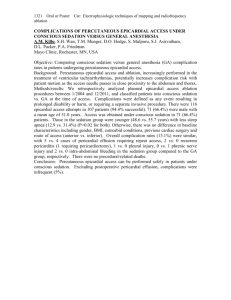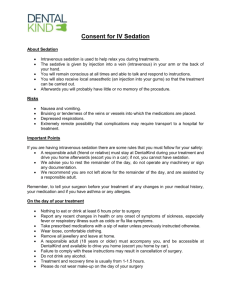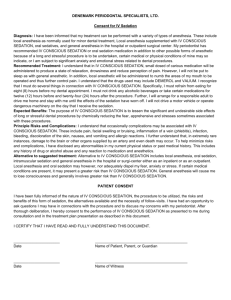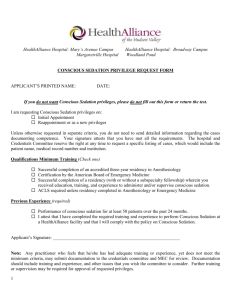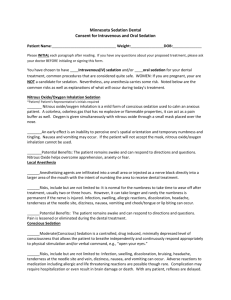21 NCAC 16Q .0402 MINIMAL CONSCIOUS SEDATION PERMIT
advertisement
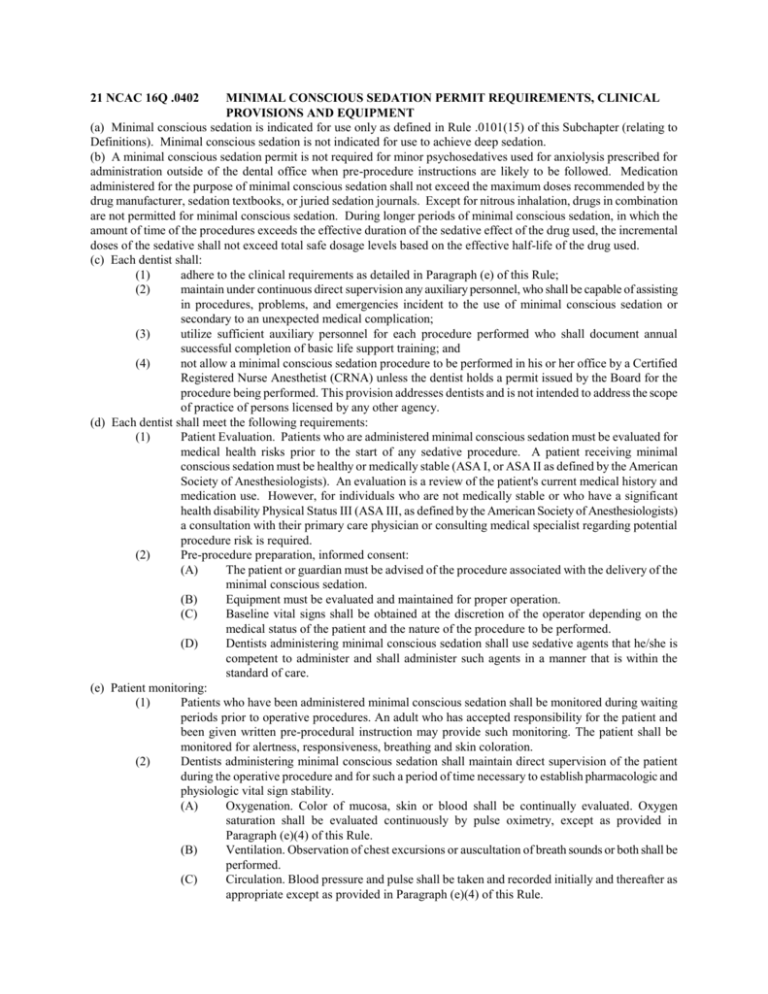
21 NCAC 16Q .0402 MINIMAL CONSCIOUS SEDATION PERMIT REQUIREMENTS, CLINICAL PROVISIONS AND EQUIPMENT (a) Minimal conscious sedation is indicated for use only as defined in Rule .0101(15) of this Subchapter (relating to Definitions). Minimal conscious sedation is not indicated for use to achieve deep sedation. (b) A minimal conscious sedation permit is not required for minor psychosedatives used for anxiolysis prescribed for administration outside of the dental office when pre-procedure instructions are likely to be followed. Medication administered for the purpose of minimal conscious sedation shall not exceed the maximum doses recommended by the drug manufacturer, sedation textbooks, or juried sedation journals. Except for nitrous inhalation, drugs in combination are not permitted for minimal conscious sedation. During longer periods of minimal conscious sedation, in which the amount of time of the procedures exceeds the effective duration of the sedative effect of the drug used, the incremental doses of the sedative shall not exceed total safe dosage levels based on the effective half-life of the drug used. (c) Each dentist shall: (1) adhere to the clinical requirements as detailed in Paragraph (e) of this Rule; (2) maintain under continuous direct supervision any auxiliary personnel, who shall be capable of assisting in procedures, problems, and emergencies incident to the use of minimal conscious sedation or secondary to an unexpected medical complication; (3) utilize sufficient auxiliary personnel for each procedure performed who shall document annual successful completion of basic life support training; and (4) not allow a minimal conscious sedation procedure to be performed in his or her office by a Certified Registered Nurse Anesthetist (CRNA) unless the dentist holds a permit issued by the Board for the procedure being performed. This provision addresses dentists and is not intended to address the scope of practice of persons licensed by any other agency. (d) Each dentist shall meet the following requirements: (1) Patient Evaluation. Patients who are administered minimal conscious sedation must be evaluated for medical health risks prior to the start of any sedative procedure. A patient receiving minimal conscious sedation must be healthy or medically stable (ASA I, or ASA II as defined by the American Society of Anesthesiologists). An evaluation is a review of the patient's current medical history and medication use. However, for individuals who are not medically stable or who have a significant health disability Physical Status III (ASA III, as defined by the American Society of Anesthesiologists) a consultation with their primary care physician or consulting medical specialist regarding potential procedure risk is required. (2) Pre-procedure preparation, informed consent: (A) The patient or guardian must be advised of the procedure associated with the delivery of the minimal conscious sedation. (B) Equipment must be evaluated and maintained for proper operation. (C) Baseline vital signs shall be obtained at the discretion of the operator depending on the medical status of the patient and the nature of the procedure to be performed. (D) Dentists administering minimal conscious sedation shall use sedative agents that he/she is competent to administer and shall administer such agents in a manner that is within the standard of care. (e) Patient monitoring: (1) Patients who have been administered minimal conscious sedation shall be monitored during waiting periods prior to operative procedures. An adult who has accepted responsibility for the patient and been given written pre-procedural instruction may provide such monitoring. The patient shall be monitored for alertness, responsiveness, breathing and skin coloration. (2) Dentists administering minimal conscious sedation shall maintain direct supervision of the patient during the operative procedure and for such a period of time necessary to establish pharmacologic and physiologic vital sign stability. (A) Oxygenation. Color of mucosa, skin or blood shall be continually evaluated. Oxygen saturation shall be evaluated continuously by pulse oximetry, except as provided in Paragraph (e)(4) of this Rule. (B) Ventilation. Observation of chest excursions or auscultation of breath sounds or both shall be performed. (C) Circulation. Blood pressure and pulse shall be taken and recorded initially and thereafter as appropriate except as provided in Paragraph (e)(4) of this Rule. (D) AED. Dentists administering minimal conscious sedation shall maintain a functioning automatic external defibrillator (AED). (3) An appropriate time oriented anesthetic record of vital signs shall be maintained in the permanent record including documentation of individual(s) administering the drug and showing the name of drug, strength and dosage used. (4) If the dentist responsible for administering minimal conscious sedation must deviate from the requirements set out in this Rule, he or she shall document the occurrence of such deviation and the reasons for such deviation. (f) Post-operative procedures: (1) Following the operative procedure, positive pressure oxygen and suction equipment shall be immediately available in the recovery area or operatory. (2) Vital signs shall be continuously monitored when the sedation is no longer being administered and the patient shall have direct continuous supervision until oxygenation and circulation are stable and the patient is sufficiently responsive for discharge from the office. (3) Patients who have adverse reactions to minimal conscious sedation shall be assisted and monitored either in an operatory chair or recovery area until stable for discharge. (4) Recovery from minimal conscious sedation shall include: (A) cardiovascular function stable; (B) airway patency uncompromised; (C) patient easily arousable and protective reflexes intact; (D) state of hydration within normal limits; (E) patient can talk, if applicable; (F) patient can sit unaided, if applicable; (G) patient can ambulate, if applicable, with minimal assistance; and (H) for the patient who is disabled, or incapable of the usually expected responses, the presedation level of responsiveness or the level as close as possible for that patient shall be achieved. (5) Prior to allowing the patient to leave the office, the dentist shall determine that the patient has met the recovery criteria set out in Paragraph (f)(4) of this Rule and the following discharge criteria: (A) oxygenation, circulation, activity, skin color and level of consciousness are sufficient and stable and have been documented; (B) explanation and documentation of written postoperative instructions have been provided to the patient or a responsible adult at time of discharge; (C) responsible individual is available for the patient to transport the patient after discharge; (D) A vested adult must be available to transport patients for whom a motor vehicle restraint system is required and an additional responsible individual must be available to attend to the patients. (g) The dentist, personnel and facility shall be prepared to treat emergencies that may arise from the administration of minimal conscious sedation, and shall have the ability to provide positive pressure ventilation with 100% oxygen with an age appropriate device. History Note: Authority G.S. 90-28; 90-30.1; Temporary Adoption Eff. December 11, 2002; Eff. August 1, 2004; Amended Eff. July 3, 2008.
